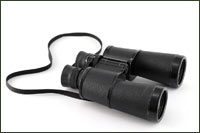 Bird watching equipment includes binoculars, a book on bird identification, a checklist and a notebook for observations. There really isn’t much aside from these except for a hat to cover one’s head, a vest to put some small essentials in and comfortable walking shoes to support one’s feet. The last things mentioned may be needed for bird watching trips but may not be necessary if bird watching is done in one’s own backyard. Professional requirements may necessitate the use of other equipments to complement the basic binoculars.
Bird watching equipment includes binoculars, a book on bird identification, a checklist and a notebook for observations. There really isn’t much aside from these except for a hat to cover one’s head, a vest to put some small essentials in and comfortable walking shoes to support one’s feet. The last things mentioned may be needed for bird watching trips but may not be necessary if bird watching is done in one’s own backyard. Professional requirements may necessitate the use of other equipments to complement the basic binoculars.
Bird watching or Birders are considered the most demanding users of binoculars since there is a need to identify the birds aside from spotting them. This would require very sharp views so that fine details can be observed. The optics used should be able to provide the best view possible in all conditions. This is because bird watching is done at all hours of the day and night in whatever condition or environment. Views of birds are often of limited duration so the equipment used is very crucial. The quality of a very short look will determine whether or not an identification can be made.
Essentially, a binoculars’ efficiency is subject to the image of the optics in relation to its design, quality of materials and other manufacturing factors; the ease of use; durability and weather resistance and the general feel when its owner uses it. This is one case where price increases proportionately with quality and features. High-quality optics performs well in all conditions while delivering the sharpest image with the truest color. They come in ergonomic designs that maximize comfort during use. However, there is not one design of binoculars that is recommended for all users. The ideal one is determined by what the user wants from it, the conditions where the equipment will be used and the amount allotted for the cost of buying it.
 There are two main optic designs in modern binoculars and spotting scopes. These are the Porro Prism which consists of two mirrors mounted separately and the Roof Prism which consists of two prisms cemented together in a single interior mount. The difference in durability, image and optical quality are most noticeable between lower and middle-priced optic with less dramatic changes between middle and high-priced ones. The two types of optic designs reach peaks in each of the factors at different price levels.
There are two main optic designs in modern binoculars and spotting scopes. These are the Porro Prism which consists of two mirrors mounted separately and the Roof Prism which consists of two prisms cemented together in a single interior mount. The difference in durability, image and optical quality are most noticeable between lower and middle-priced optic with less dramatic changes between middle and high-priced ones. The two types of optic designs reach peaks in each of the factors at different price levels.
Compact binoculars are not usually recommended for primary use although it has its uses. All the issues considered in choosing full-sized binoculars also hold true in compact ones. A spotting scope will be necessary if a magnification greater than 7X to 10X is desired. A birding tripod should be a compromise of weight VS stability and between compactness VS height. A Night vision device greatly enhances wild life viewing even in the darkest conditions. Other equipments that can make bird watching a lot more enjoyable include monocular, digital camera binoculars and laser range finders.
Choosing binoculars for children would require some careful attention. The most obvious considerations are size and weight. An indestructible pair of toy binoculars would be sufficient for toddlers. Preschoolers would benefit from a lightweight and low-power device with a wide field of view. Preteens can be given their first pair of real binoculars where optical quality starts to matter. Bird watching can be a very fulfilling family experience made more enjoyable with the use of the right equipments and devices.